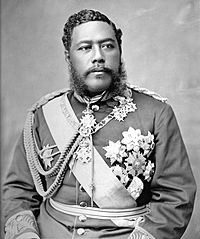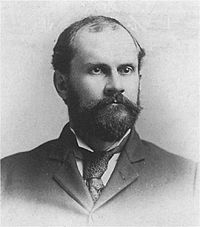1887 Constitution of the Hawaiian Kingdom facts for kids
The 1887 Constitution of the Hawaiian Kingdom was a special legal paper. It was created by people who wanted to take power away from the Hawaiian King. This document shifted power to wealthy American, European, and some native Hawaiian leaders. It became known as the Bayonet Constitution because King Kalākaua was forced to sign it. An armed group used threats to make him agree, or else he would lose his throne.
Contents
A Forced Change: The 1887 Rebellion
On June 30, 1887, a group of people met in Hawaii. This group included the Honolulu Rifles, an armed militia made up mostly of white soldiers. These soldiers were secretly part of the Hawaiian League. Politicians from the Reform Party of the Hawaiian Kingdom were also there.
They demanded that King Kalākaua fire his government leaders, especially Walter M. Gibson. They were worried about Gibson because he strongly supported the King's power.
Sanford B. Dole led the meeting, and Peter Cushman Jones was in charge. Jones was the head of the biggest sugarcane farm company in Hawaii. The Hawaiian League and Americans already controlled most of Hawaii's wealth. Lorrin A. Thurston, a key person who later helped overthrow the Hawaiian monarchy, wrote down their demands for the King. The group also insisted that a new constitution be written.
The next morning, July 1, 1887, some hunting guns were found on a ship. The Honolulu Rifles quickly took control. They arrested Walter M. Gibson and threatened him. King Kalākaua asked for help from representatives from the United States, Britain, France, Portugal, and Japan. But they all told him he should just agree to the demands. So, he did.
After this, Thurston became a very powerful government minister. Gibson was later sent away to San Francisco.
In less than a week, a new constitution was written. A group of lawyers, including Thurston, Dole, and others, wrote it. All of them were connected to the Hawaiian League. This group had always wanted to end the Hawaiian Kingdom and have it join the United States.
King Kalākaua signed the document on July 6, 1887. He signed it even though there were many arguments about how much it would change things.
The new constitution took away most of the King's personal power. It gave more power to the government's law-making body (the legislature) and his cabinet (his main advisors). People called it the "Bayonet Constitution" because the King was forced to sign it with threats. Thurston and Dole said they didn't use threats. But Queen Liliʻuokalani, Kalākaua's sister and later queen, said his life was in danger. She stated, "He signed that constitution under absolute compulsion."
It's important to know that the new constitution was never officially approved by the Hawaiian Kingdom's legislature.
What the New Constitution Changed
The 1887 constitution made big changes to how the Hawaiian government worked.
Less Power for the King
Before, the King could completely stop any new law (this was called an absolute veto). The new constitution changed this. Now, if two-thirds of the legislature of the Hawaiian Kingdom agreed, they could overrule the King's veto.
The King also lost the power to make decisions without his cabinet's approval. The legislature, which was mostly controlled by white Americans, now had the power to fire the cabinet, not the King. The new constitution also made it clear that the King had to follow the laws, just like everyone else. He was no longer seen as being above the law.
To reduce the King's influence, he was not allowed to appoint lawmakers to other government jobs. The legislature also gained the power to put people in jail if they disrespected, lied about, threatened, or attacked any of its members.
Changes to Lawmakers
The constitution also took away the King's power to choose members of the House of Nobles. This was the upper house of the legislature. Instead, these members were now elected by wealthy landowners. They served for six years, and the group grew to 40 members.
To become a noble or a representative, people now needed to have a lot of property and a high income. This rule meant that almost all native Hawaiians could not serve in the legislature.
Money and Voting Rules
The 1887 constitution also tried to stop the King from spending too much money. King Kalākaua had spent a lot on building and keeping up Iolani Palace. The constitution said the King had to choose a Minister of Finance to watch government spending. This minister also had to give a yearly budget plan to the legislature.
The 1887 constitution changed who could vote. It allowed foreigners living in Hawaii to vote, not just those who had become citizens. However, people from Asia, who had been able to vote before, were specifically stopped from voting.
Only Hawaiian, American, and European men could vote if they met certain money and reading rules.
The older 1864 constitution had required voters to earn at least US$75 a year or own property worth at least US$150. These wealth rules were removed in 1874, allowing more Hawaiians to vote for the lower house.
But the 1887 constitution brought back strict money rules for voting for the upper house (or serving in it). You needed an income of US$600 or property worth US$3000. This rule meant that about two-thirds of the Hawaiian population could not vote for the upper house. Most of the people who could still vote were wealthy white men from the sugar industry.
By giving power to the cabinet, appointing their own members to the cabinet, and stopping their opponents from voting, the Hawaiian League took full control of the Hawaiian Kingdom.
The Bayonet Constitution was the first major step in weakening the Hawaiian monarchy. It did not remove the King from power, but it greatly limited what he could do.



